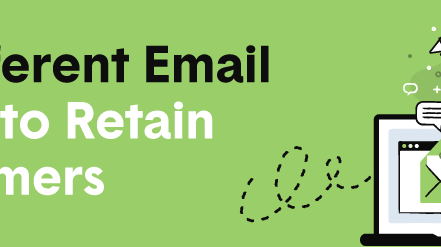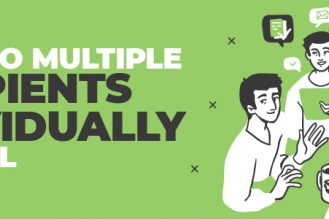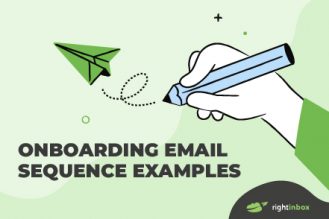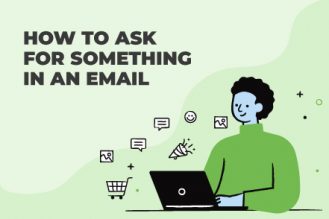Investing in email marketing can increase brand awareness and customer satisfaction. However, the average email open rate is around 20%, so sending emails consistently can feel like a strain if you’re not seeing growth in your open rates, click-through rates, or conversion rates. That’s where different email types come in.
Each type of email has its own average open rate and place in an email campaign. Even if you’ve determined the best time to send an email or settled on an email cadence, it’s just as important to create personalized emails for your customers so they don’t feel like you’re spamming them with sales-driven requests.
If it seems like no one is opening your emails, maybe it’s time to stop sending simple plain text emails and explore more personalized options. Before you start scheduling messages or redesigning your email marketing campaign, read this guide on the best types of emails for retaining customers.
1. Welcome Emails
First impressions matter. When a customer lands on your website and subscribes to your email list, makes a purchase, or inquires about your company, you need to make your first response count. Because they’re inquiring about you, making them feel welcome as a person and not just as a customer can make a difference in their future loyalty and company interactions. This is where welcome emails shine.
While general email open rates are fairly low, welcome emails have an open rate of a whopping 50%. Readers want to be recognized, so welcome emails should thank them for their actions and acknowledge them as an important part of the brand. Using a welcome email template can help you design an aesthetically pleasing message with personalized content.
Pros:
- Creates brand awareness for companies and products
- Showcases popular products or offers
- Includes tips for getting started with subscriptions
- Automatically connects with new leads
2. Newsletter Emails
While many people think newsletter emails are old news, they’re not. Newsletters are great for building brand awareness, continually communicating with your audience, and showcasing your expertise.
Newsletter emails use a consistent template and schedule so readers know when new blog content and company updates should hit their inbox. Plus, newsletters are a great place to add CTA buttons to company products, services, or downloadable materials, which can increase conversions, purchases, and sign-ups to email lists or events!
Pros:
- Shares industry or company updates consistently
- Repurposes content
- Creates expectation in the readers
- Builds brand awareness and customer relationships
3. Lead Nurturing Emails
It’s not worth creating an email just for the sake of sending your email list a piece of content. Instead, lead nurturing emails help you curate content that speaks directly to the needs, questions, or interests of your audience.
Lead nurturing emails are designed to help you lead potential or previous customers through the sales funnel. Simply providing your customers with a lead nurturing email can ease them into the process while building trust that your company will guide them through future conversations, too.
Pros:
- Focuses content on behavior, including questions
- Converts visitors into customers and repeat customers
- Offers free tips to potential customers
- Keeps your brand and products top of mind
4. Products and Services Emails
One of the best emails for retaining customers is products and services emails, more commonly referred to as marketing emails. These emails are meant to educate the reader about specific products and services, but shouldn’t be so sales-heavy that customers feel their needs or questions aren’t being addressed.
There are plenty of benefits to sending marketing emails, but they’re especially effective for sending in bulk. Seasonal products, sales offers, and more are great for almost any audience. However, be aware that sending bulk emails can increase the possibility of reaching spam folders, so it’s important to double-check the relevance of your email list before hitting send.
Pros:
- Simplifies valuable content
- Keeps products and services the topic of conversation
- Appeals to the masses but can be personalized
- Targets past, present, and future customers
5. Announcement Emails
Have a new seasonal product, hired a new staff member, or need to announce a grand opening? Well, send an announcement email! This type of email can be planned or unplanned, but it should be sent naturally as events in the life of your business unfold.
Announcement emails are especially great if your product solves a common issue. For example, Right Inbox’s Mail Merge assists customers with their cold email outreach, and a helpful integration like this should be announced to prospective users! Plus, announcement emails keep your customers informed on changes in your business while also making them feel like important members of the brand.
Pros:
- Creates anticipation for future product or service launches
- Includes CTAs for About and Contact pages
- Keeps products, services, and brand top of mind
- Adds variety to an email marketing campaign
6. Milestone Emails
To retain customers, it’s important to celebrate their successes and milestones just as much as yours. Milestone emails for birthdays and subscription anniversaries hardly go unopened, and they help foster company-customer relationships.
Simply sending a “Happy Birthday!” message can increase unique click-through rates by 179%. Plus, this email type is perfect for sneaking little milestone offers like a free gift or a discount to your dedicated customers.
Pros:
- Supports relationships with customers
- Increases open and click-through rates
- Provides personalized communication
- Reinforces customer loyalty
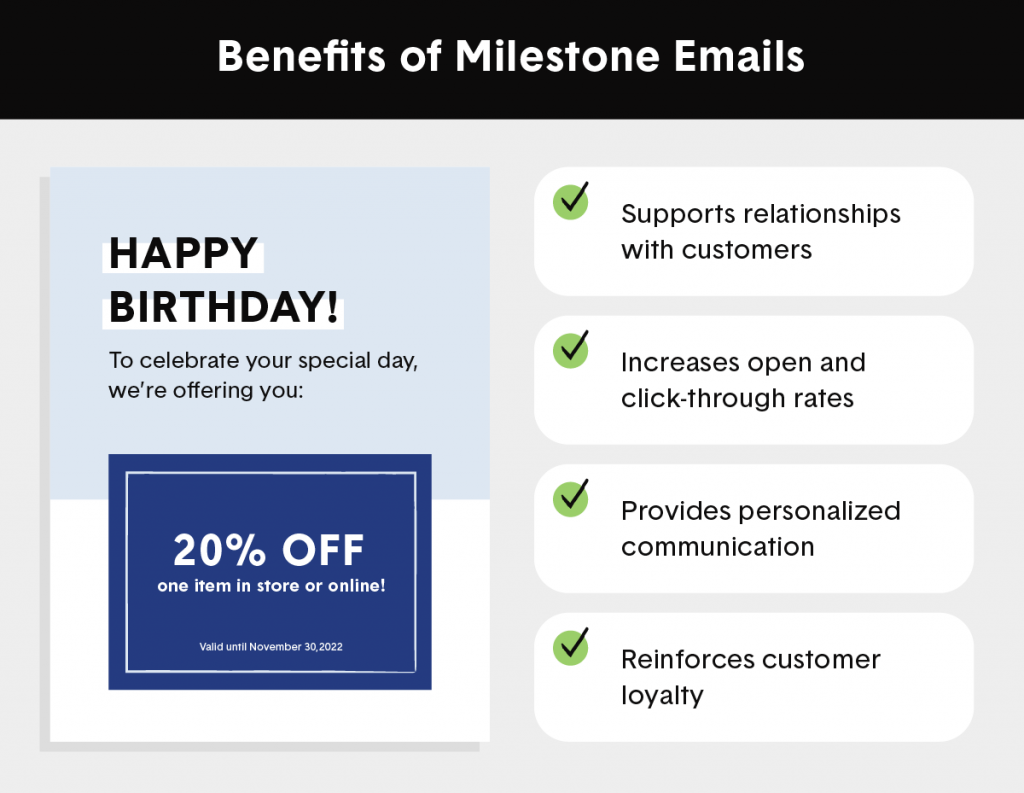
7. Promotional Emails
Promotional emails are common in email marketing campaigns because 91% of people actually enjoy receiving them. These types of emails are often referred to as special offer emails because they send special offers directly to a potential customer’s inbox. Who doesn’t love having a sale notice, discount, or coupon for their favorite brand delivered right to the palm of their hand?
Promotional emails should be used regularly, and they should be designed to drive clicks and transactions. Plus, these emails don’t need to be for online sales only — they can send customers to physical stores, pop-ups, or mobile apps, too!
Pros:
- Promotes products and offers simultaneously
- Encourages customers to visit websites or physical stores
- Targets specific sales, discounts, or coupons
- Easily sent in bulk or personalized for certain groups
8. Offer Emails
Different than a promotional email, offer emails are used to announce specialized offers — including sales, free gifts, or other incentives — in exchange for a transaction. For example, a company could offer free email templates, coloring sheet downloadables, or an exclusive sale for anyone willing to sign up for their email list.
Offer emails can be sent to non-subscribers to entice them to join a group or sign up for an event, to current subscribers who haven’t taken advantage of previous offers, or to past subscribers to remind them of what they could receive again.
Pros:
- Communicates with customers in every step of the buyer’s journey
- Brings more brand and product awareness
- Focuses on specific offers
- Useable in an email sequence
9. Progress Emails
While practice doesn’t always make perfect, it does make progress, and customers want to see their progress. Sending out progress emails notifies customers of their improvements when using your products and services, which can keep them coming back for more.
Progress emails should be sent consistently. If there seems to be a regression or plateau in the effects of the products or services, this is a great place to offer additional advice, point customers toward similar products, or provide additional insight into your company’s services.
Pros:
- Motivates customers to continue using products or services
- Highlights multiple services and their benefits at once
- Compiles data for business or company use
- Prompts users to continue through or restart the buyer’s journey
10. Storytelling Emails
Every brand, company, and business has a unique story about where it started or how it created its product. Storytelling emails and brand story emails help solidify your history and reputation within your field.
Customers want to be emotionally invested in the success of their favorite brands, but they also want to interact with brands that have a proven track record of success. Using your brand’s story can set you apart from your competitors, keeping your customers coming back time and time again.
Pros:
- Creates an emotional connection with customers
- Builds brand reputation
- Sets a company apart as unique and one of a kind
- Makes a brand more approachable and understandable
11. Transactional Emails
Transactional emails are triggered when a customer takes a certain action on a website or landing page. These emails can be digital receipts, shipping confirmations, product recommendations after a sale, or other informational messages about products or services.
While transactional emails may seem mundane, they remind your past customers who you are and what you provide. Most importantly, they can bring a customer back to your website or brand, even after they’ve completed a purchase or transaction.
Pros:
- Increases the possibility of opens and clicks
- Keeps a brand top of mind
- Builds brand trust and communication
- Provides customers with additional product and service information
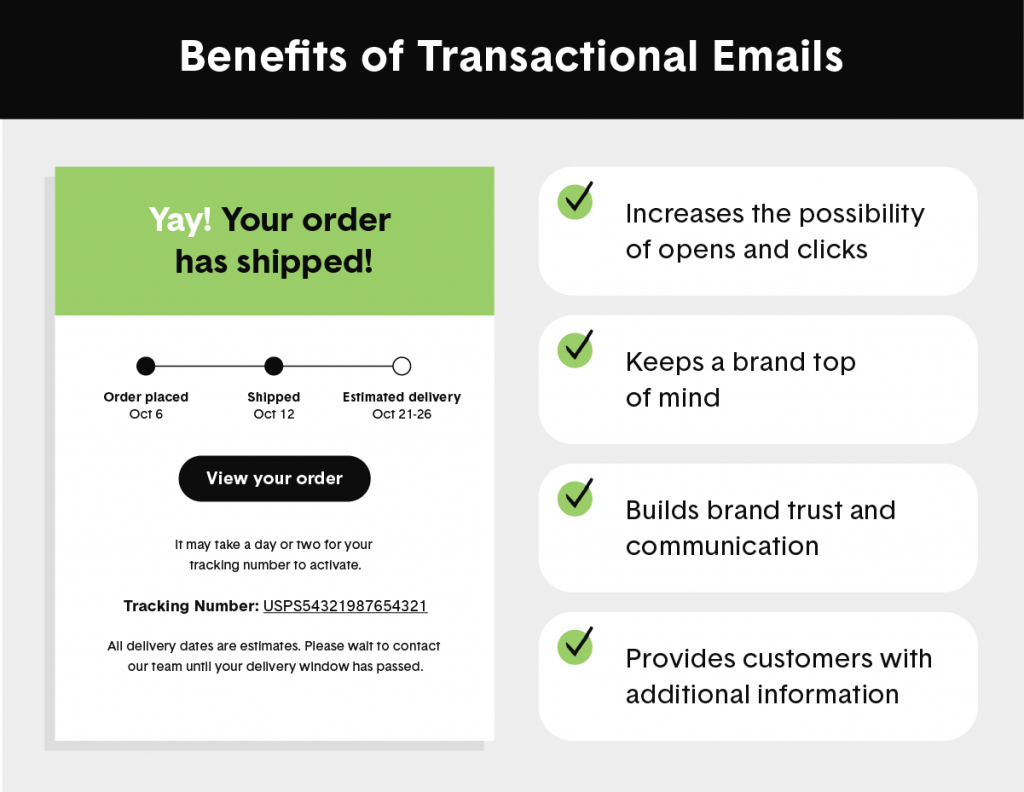
12. Video Emails
The increased demand for video content has affected many businesses. Many customers want to see a product or service in action before committing to a transaction, so video emails have become popular marketing tools. Not to mention, many consumers like to know the owners of their product firsthand, so video allows them to see a face, hear a voice, and connect with a brand!
Simply creating a video, writing out a short piece of content, and ending your message with a unique email signature is a great way to start sending video emails. It’s even possible to embed a YouTube video into your email to give your message some character.
Pros:
- Shares company story, products, and expertise
- Introduces a company’s workers and executives
- Engages customers with your product or service
- Helps customers retain information about your company
13. Standalone Emails
Standalone emails, or dedicated emails, are exclusively designed to promote singular offers, including products or services. These emails often lead to a single landing page dedicated to a service, product, or offer.
Instead of including multiple CTAs, similar products, or sales, standalone emails focus on a single offer and most likely use minimal design elements to reduce customer distraction.
Pros:
- Focuses on one product, service, or offer
- More cost-effective with minimal design
- Produced quickly and efficiently
- Needs minimal unique content
14. Reminder Emails
After you’ve sent a promotional email, a marketing email, or a standalone email, it’s important to send follow-up emails. Instead of expecting your customers to remember a sale, new product, or event, incremental reminder emails can keep your business top of mind.
Reminder emails can be manually sent or scheduled to send at certain times, and frequently, more than one reminder is sent to each customer. Commonly, reminder emails are sent near the end of free trials, ongoing sales, or event sign-ups, but they can be sent whenever you are offering a unique feature or service.
Pros:
- Keeps products and services top of mind
- Provides plenty of opportunities for customers to interact with a brand
- Encourages customer action
- Can be sent in bulk and frequently
15. Abandoned Cart Emails
While it’s less likely for someone to abandon a shopping cart full of produce in the aisle of a grocery store, it’s not unlikely for a prospective consumer to desert their online shopping cart before completing a transaction. When this happens, it’s important to send an abandoned cart email to nudge these consumers to complete their purchases.
45% of abandoned cart emails are opened, so including offers like coupons, free shipping, or discount codes can help persuade shoppers to click “buy” instead of sending the email to spam. Plus, these emails can be automatically triggered by a customer’s action — or inaction — so you don’t have to monitor every prospective customer or website visitor!
Pros:
- Offers additional discounts
- Provides a direct link to the checkout page
- Addresses customer questions and concerns
- Creates a sense of importance for the customer
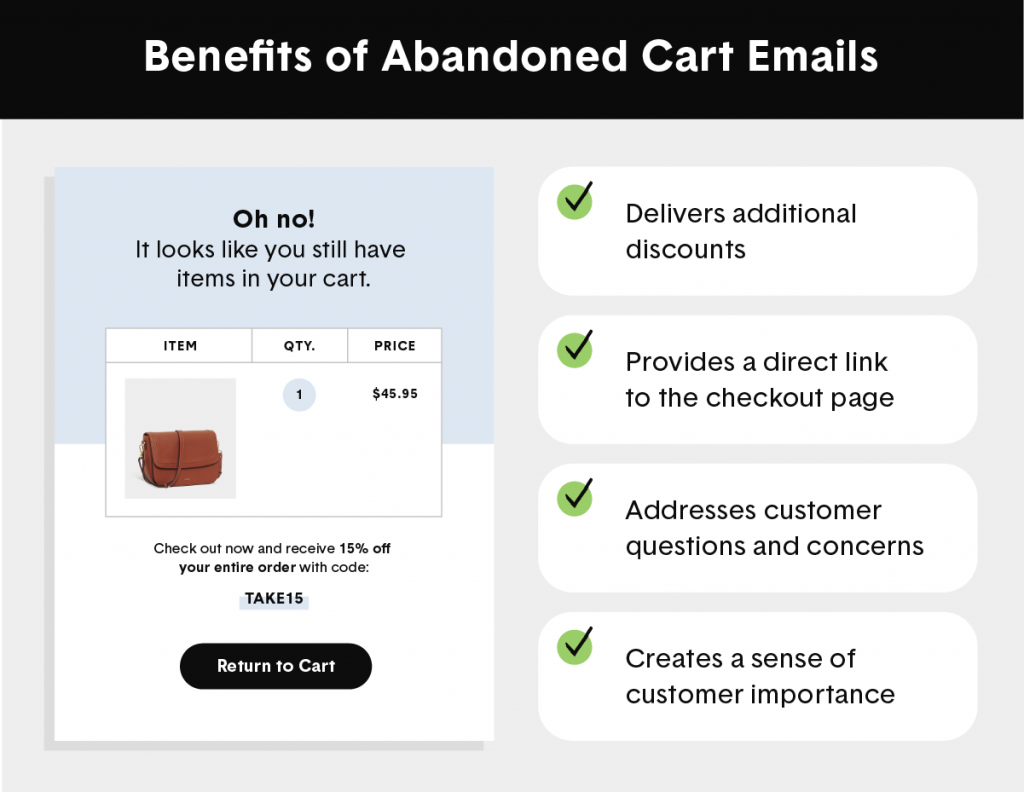
16. Confirmation Emails
Retaining customers through email can be as simple as providing them with necessary purchase information. Has a customer ordered one of your products or signed up for a service you offer? Send them a confirmation email to let them know you received their request!
Efficient communication after a transaction builds brand trust and sets up customer expectations for continued outreach. Using confirmation email templates and creating auto-replies can streamline the process.
Pros:
- Builds customer trust
- Sets up communication expectations
- Closes the sales funnel
- Provides a communication trail for receipts and returns
17. Review Request Emails
Business reviews can be crucial to the success of a business. Since 77% of consumers read reviews before considering making a purchase or investing in a service, positive reviews can make or break future business prospects.
Asking customers to leave reviews on sites like Yelp and Google Business Reviews allows them to express their feelings toward a product or service while being invested in the business itself.
Pros:
- Provides insight into products, services, and customers
- Supports communication between customers and businesses
- Increases brand transparency
- Spreads brand awareness
18. Survey Emails
Personal survey emails show your readers and customers that you care about their experiences when they interact with your business. Instead of asking for feedback on public review sites, survey emails provide a more personalized feedback experience.
Survey emails allow customers to submit private reviews directly to you or another member of your organization. Asking questions like, “How was our service?” and “What can we do to improve your experience?” puts the customer at the center of the transaction, increasing their potential loyalty to your business.
Pros:
- More cost-effective than other feedback collection methods
- Gathers data easily
- Allows for honest feedback
- Increases convenience for responses
19. Free Gift Emails
Everyone’s favorite F-word is “free” when it comes to businesses, products, and services. Free email campaigns can excite potential customers about your products, convince them to subscribe to your email list for future campaigns, and potentially turn them into paying customers.
The key to sending successful free gift emails is to send them at random. Offering downloadables and templates, gifts for spending a certain amount, or other incentives randomly keeps your readers on their toes and interested in new, upcoming products.
Pros:
- Creates interest in the business and products
- Attracts buyers to your business
- Increases memorability
- Sets a standard for products and services
If you need help starting your email marketing campaign, email templates can help you craft the best messages for your audience. Plus, email tracking can help you determine if the email types you chose to send are reaching their intended audience or performing well!
Track emails, email reminders & templates in Gmail for free
Upgrade Gmail with the features it’s missing
Add to GmailDavid Campbell
David Campbell is the editor of the Right Inbox blog. He is passionate about email productivity and getting more done in less time.
